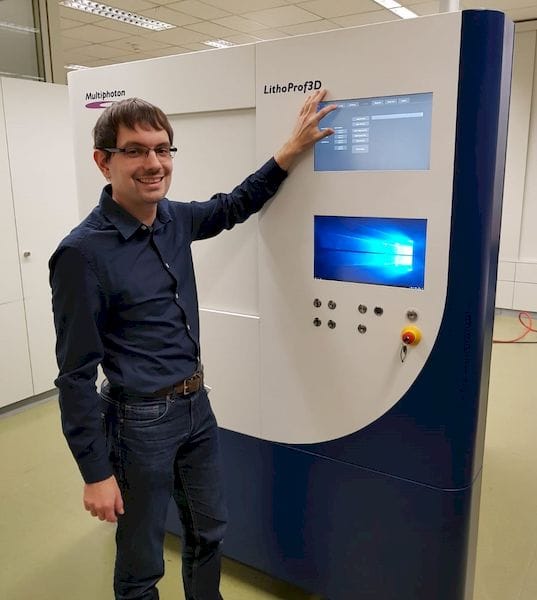![The LithoProf3D series [Source: Multiphoton Optics]](https://fabbaloo.com/wp-content/uploads/2020/05/image-asset_img_5eb09d8ead35e.jpg)
Multiphoton Optics has just launched their new LithoProf3D series.
The Würzburg, Germany-based company was founded in 2013, as a spin-off from the famous Fraunhofer Institute, which has initiated quite a few highly unusual 3D printing ventures, and this is one of them.
Since their founding, the company has received two significant rounds of investment to power their operations. With this money they were able to produce a very high-resolution 3D printer.
When I say, “high-resolution”, I’m not kidding: the LithoProf3D series fills an otherwise empty zone in the range of 3D printing in between conventional desktop 3D printing and microscopic 3D printing.
![A tiny, but high-precision, lens box produced on the LithoProf3D [Source: Multiphoton Optics]](https://fabbaloo.com/wp-content/uploads/2020/05/image-asset_img_5eb09d8f24cc9.jpg)
Let’s look at some of the specifications. The build volume is small, at 100 x 100 x 50mm, when compared to typical desktop 3D printers, but it’s what happens in that small volume is important. The minimum feature size capable of being printed by the LithoProf3D is only 100nm. That’s 0.0001mm. Very Small.
You can see the incredible precision of prints emerging from this device in this timely sample model:
![A very small, high-resolution NFL-themed 3D print made on the LithoProf3D [Source: Multiphoton Optics]](https://fabbaloo.com/wp-content/uploads/2020/05/image-asset_img_5eb09d8f79caf.jpg)
They achieve this incredible resolution by their “two-photon polymerization” approach. While this is a resin process, somewhat reminiscent of the SLA process, a specially designed pulsed laser is flashed for an ultra-short duration, fusing a very small volume within a tiny focal area.
The machine targets industrial use, and has a number of features inside and outside it to facilitate that goal. One of the aspects of the new series is a fully integrated workflow that not only allows for industrial 3D printing, but also several other integrated making processes, including subtractive capability for working on thin metal films and creating microstructures on photoresponsive glass.
It’s also quite modular, allowing buyers to selectively install additional options that may be appropriate for specific workflows. The options include:
-
Vision2Align3 – High-precision detection of alignment marks, assemblies, and components for adapted automated processes for Level 0 and Level 1 packaging using solely passive alignment to create optical interconnects, optical packages, and optical elements on active or passive optical components.
-
LithoBath3D3 – Easy to exchange exposure configuration for large scale structures in the cm range with no adjustment necessary.
-
Wafer Chuck3 – Holds wafers or other sample formats in place for High-Precision 3D Printing.
-
LithoDILL3D4 – Provides capability of Dip-In 3D Printing.
The LithoProf3D is accompanied by a powerful software suite that enables smooth operation of complete workflow to produce industrial 3D prints. Their suite includes functionality to prepare multiple model print jobs, combine objects, slice print jobs, swiftly create smooth optical lens designs, automatically design random woodpile-like structures, and design diffractive optical elements.
These software features hint at the possible applications of the LithoProf3D, which include making optical elements of various types. The exceptional resolution and material capabilities make it ideal for such use. In addition to optical, Multiphoton Optics also cites medical, biomedical, mobile, computing, mechanics, illumination, imaging, displays, automotive, AR, VR, and sensors as other possible application areas.
Basically, the resolution is so fine from this equipment that it is very possible to directly produce usable optical elements. That’s not something that can be done on other 3D printing equipment.
The LithoProf3D is one of the more unusual 3D printers we’ve looked at, and it could be of great value to specific industries. However, it’s entirely possible new applications could be discovered by those industries exploring how micro-3D printing could benefit their operations.











FELIXprinters has released a new bioprinter, the FELIX BIOprinter, which is quite a change for the long-time 3D printer manufacturer.